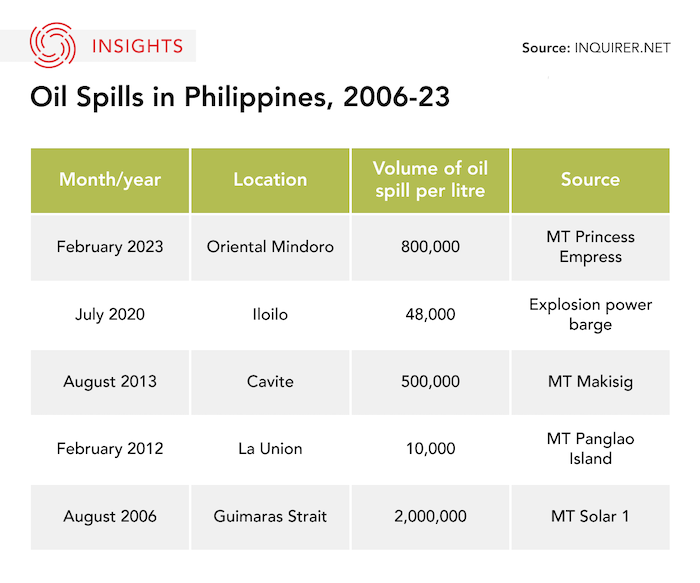The Takeaway
A large oil spill from a tanker carrying 800,000 litres of industrial oil that sank off the coast of Oriental Mindoro province in southwest Philippines is threatening the biodiversity of 21 nearby marine protected areas and the livelihoods of Filipinos working in the fishing and tourism sectors. The environmental disaster has prompted a Philippine Senate probe that has so far revealed government failures and raised questions over the seaworthiness of the vessel, cleanup responsibility, and co-ordination efforts to contain the spill.
In Brief
MT Princess Empress, the tanker carrying 800,000 litres of industrial fuel oil, sank off the central island of Mindoro, south of the capital, Manila, on February 28. En route to Iloilo from Limay, Bataan, the tanker had engine troubles. It drifted towards the coastal municipality of Naujan on strong currents before sinking, according to a preliminary report by the Department of Environment and Natural Resources (DENR). The Philippine Senate launched a probe into the origin and impact of the oil spill on March 14. Initial findings have revealed that the tanker allegedly sailed out nine times – including on February 28 – without an updated permit, raising questions around the permit granting process by the Philippine Coast Guard (PCG) and the national maritime regulator, the Maritime Industry Authority (MARINA).
Implications
Probe investigators uncovered conflicting reports about the issuance of an updated ‘Certificate of Public Convenience’ (CPC), or domestic maritime operating licence, to RDC Reield Marine Services (RDC), the Philippines-based operator of the vessel. Per MARINA regulations, operators must update or amend their CPCs if they acquire new vessels, which RDC claimed was the case with the MT Princess Empress. MARINA has claimed it did not issue a CPC and that the tanker had no permission to sail. PCG justified the tanker’s permission to sail by presenting a supposed MARINA-issued CPC. Questions about the CPC’s authenticity have prompted the Department of Transportation to investigate allegations of possible forgery within these agencies.
As one of the investigators, the Philippine Department of Justice has also alleged that the MT Princess Empress was a 50-year-old rebuilt scrap ship rather than a purpose-built tanker, contradicting the operator’s claim that the sunken vessel was new. Senate officials have conceded that the lax permit granting process may have emboldened the vessel’s operators to neglect the rules and lambasted PCG and MARINA for failing to undertake due diligence in preventing the crisis.
Meanwhile, the oil slick has spread across 40 km off Oriental Mindoro, impacting nine towns, 108,000 individuals, 61 tourist sites, and causing at least 122 people to fall sick. A fishing ban in the affected towns was declared by the government, impacting nearly 18,000 fisherfolk who depend on the sea for their food and livelihood. The spill has also reportedly reached the Verde Island Passage, a UNESCO World Heritage Site contender and one of the richest marine biodiverse ecosystems in the world. Environmental experts have raised alarms that the spill threatens 36,000 hectares of pristine marine ecosystems including coral reefs, mangroves, and seagrass beds.
Large oil spills are not new in the Philippines and yet the disaster response to the crisis has been slow, with the Senate now discussing a request to the president to appoint a lead to co-ordinate the cleanup efforts. Classified as a Tier 2-level oil spill requiring a national government response, the PCG and DENR have been trying to contain the spread of the spill, but the impacted area continues to widen, complicating rehabilitation and recovery efforts for the affected marine habitats and natural ecosystems.

What’s Next?
International cleanup assistance:
Although the spill hasn’t reached the Tier 3 level requiring assistance from the international community, countries such as Japan and the U.S. and private corporations such as Shell, Petron, and Prime Energy have offered to help with recovery and rehabilitation. The U.S and Japan have dispatched teams to assist with the cleanup, and the U.S National Oceanic and Atmospheric Administration will conduct environmental and ecosystem restoration assessments. The DENR is also discussing assistance possibilities with other Southeast Asian nations.
Tourism impacted:
The Philippines was planning to receive 4.8 million tourists this year to revive the tourism economy, which was hit hard by the COVID-19 pandemic, but the oil spill has already started to affect this target. Tourists planning to visit the affected resorts are cancelling their bookings. The oil spill also threatens world-class diving spots, including Verde Island, Apo Reef, the Coron wrecks, and Dugong, and is hurting the Philippines cruise ship sector. The impact on tourism is expected to be significant and may hinder the island nation’s longer-term economic recovery.
• Produced by CAST’s Southeast Asia team: Stephanie Lee (Program Manager); Alberto Iskandar (Analyst); Saima Islam (Analyst); and Tim Siao (Analyst).
